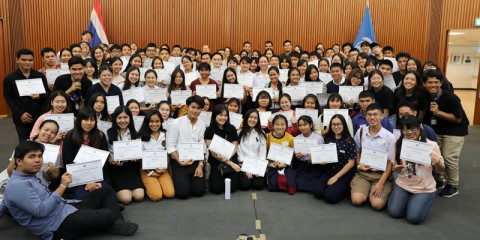
GCED Basic Search Form
Quick Search
You are here
News

Imagine you are a young person studying in a small rural town – what would be your response if someone said: “You should join the United Nations” or “Consider an international role”? Rather than being excited, you might just think “impossible”.
“I guess no one will deny the benefits of reaching out, especially joining international organizations and events,” said Nopardol Pao, from the NGO Teach for Thailand. “However, it is putting our heads in the clouds to demand that youth do so – there’s a lack of understanding and motivation for them to join in.”
Engagement with young people in international forums has always been a challenge, not just to include them, but to see them in leadership roles. Youth agency is crucial because youth are both future leaders and the people whose welfare is most at stake in development outcomes in education, gender equality, the environment and many more areas. In the decades to come, it is young people who will benefit or suffer most because of decisions made today.
In Thailand, youth can readily identify barriers to their participation, including language and information disconnects, lack of self-confidence often linked to a lack of respect, and unequal socioeconomic conditions. With all of those challenges in mind, the United Nations Asia-Pacific Interagency Network on Youth and Thammasat University’s School of Global Studies co-hosted a youth summit with the theme “transforming education” for International Youth Day 2019 on 10 August. Out of 1,000 applicants, 100 participants from secondary schools and universities across the country attended.
“The disconnect between youth and international organizations is big. There is a lack of explanation and education on how being involved in international events could help them to live a better life,” said Nopardol, guest speaker at the event who shared his experiences as a volunteer teacher in rural areas of the country. “It is not easy for youth to reach out to the UN or other opportunities, as they often believe that the UN is only for professionals with significant academic backgrounds.”
There is a certain degree of irony in this observation as the international community is often eager for greater youth engagement and yet cannot always convey that message. “The UN has a very professional image as an authority, so local students might not be confident enough to reach out to such huge organizations,” said Napakorn Saweddit, a Bangkok university student. “In most cases, we wish to join, but we don’t know how and couldn’t believe that we deserve the chance.”
A lack of confidence, however, is not necessarily a matter of insecurities, but a product of social forces and systemic bias. “Youth voices seem nothing in our society, not in school or government. The education policies and curricula design have never involved our thoughts,” Napakorn said. “Time goes by, we have become discouraged and tamed, and we cannot believe that we have the right to engage and to express ourselves, or that someone will listen to and value us.”
These factors can be aggravated as well by the rural-urban divide and socioeconomic inequalities, in many cases further marginalizing young people who are both most vulnerable and in some ways best positioned to affect meaningful change. “In this case, it is further widening the gap between the youth in cities and in rural areas,” said Thanakrit Srisuwan, a high school student from the southern provinces. “While students in cities receive more opportunity through information and support from schools, rural students are more likely to miss out, and they tend to be even more conservative in stepping out of their comfort zones to compete with others.”
Information barriers are another major reason young people are hesitant to engage, as international events, not to mention publications, are mainly in English rather than mother-tongue languages spoken by the youth who are most affected. All of these challenges are context-specific, with no one-size-fits-all solution.
Whole networks including government, schools, civil-society organizations and families need to work together to provide support and resources to build youth capabilities and awareness. However, the major key remains to listen to young people. “If you wish to convince and encourage youth to reach out, first you need to step in their shoes and think – why would they be willing?” teacher Nopardol said. “Different regions have their different concerns, we have to put ourselves in their perspectives and to understand their needs, then emphasize how the opportunities can relate to their needs.”
All of these considerations are part of UNESCO’s approach to youth engagement, addressing the importance of putting young people at the centre of the dialogue to transform the way the UN works with young people. One of the key principles is to recognize young people’s stake in the issues, and to provide youth-relevant and youth-focused interventions, while including young people and their social networks as leaders and partners.
The recent International Youth Day event in Bangkok is a case in point, organized entirely by Thammasat students who brought together their peers and focused on the issues that matter most to them. This is youth leadership, not just participation as an afterthought. Their voices should be heard.
URL:
